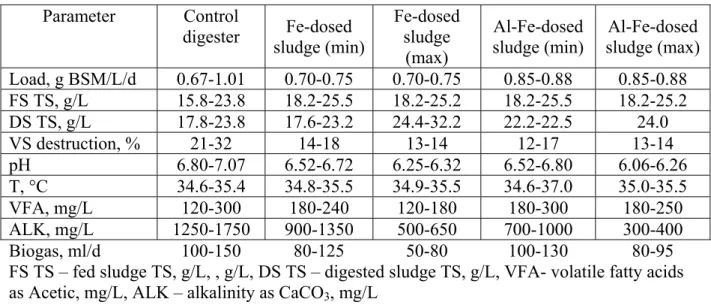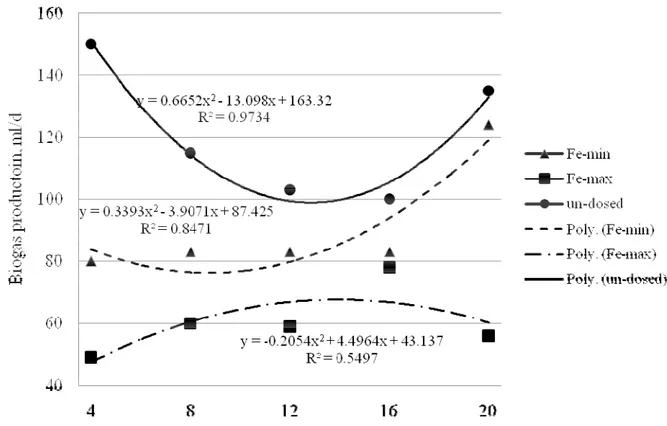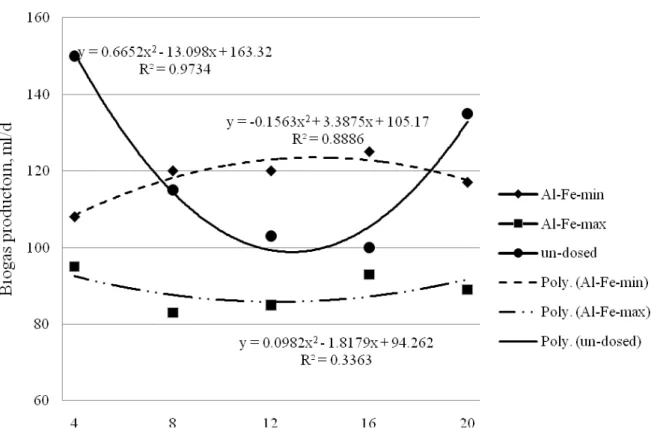AN INVESTIGATION OF IMPACT OF IRON
AND ALUMINIUM ADDITION ON THE
ANAEROBIC DIGESTION PROCESS
Svetlana Ofverstrom
Ieva Sapkaite
Regimantas Dauknys
Vilnius Gediminas Technical University, Lithuania
ABSTRACT
In this study, the impact of iron and aluminium salts addition on anaerobic digestion process was investigated. Mixture of primary and activated sludge collected at Vilnius wastewater treatment plant in Lithuania was digested under laboratory conditions by using anaerobic digester (W8, Amfield, UK). To compare the relative digestibility of iron-dosed (Fe-dosed) and aliuminium-iron-dosed (Al-Fe-dosed) sludge with un-dosed sludge three continuous experiments were made. Results showed that iron and aliuminium negatively impacted anaerobic digestion process by reducing the volume of biogas produced. Fe-dosed sludge produced 20-50% less biogas and Al-Fe-dosed sludge produced 30-40% less biogas in comparison to the same un-dosed sludge. VS destruction decreased during dosing of Fe or/and Al salt. Biogas composition was not measured during the experiments.
KEYWORDS
Wastewater sludge (primary and activated sludge), lab-scale anaerobic digestion, aliuminium salt, iron salt, biogas production.
1 INTRODUCTION
Nitrogen and phosphorus removal from wastewater is a way to avoid eutrophication of water bodies [1]. Usually there are two possible schemes to remove phosphorus – biological and chemical. The most often used method for phosphorus removal from wastewater is biological treatment. Chemical phosphorus removal involves the addition of a chemical coagulant, either aluminium (Al), iron (Fe), or lime. As a consequence of chemical phosphorus removal, the volume of sludge increases, between approximately 37% and 97% [2].
The effect of both Al and Fe on anaerobic digestion efficiency has been studied by a number of investigators with conflicting results. Gossett et al. found reduction of gas production from addition of both iron and aluminium [3, 7]. Johnson et al. found the iron rich primary sludge from chemically enhanced treatment reduced gas production by 32% while Lee found that addition of iron increased gas production [4, 5, 7]. Jackson– Moss and Duncan found that addition of up to 5,650 mg/L had no effect on an upflow anaerobic sludge blanket reactor. [6, 7] There is no general consensus of chemical phosphorus removal impact on anaerobic digestion because it is difficult to isolate impact of chemical phosphorus removal from other site-specific variables, such as sludge age and wastewater composition [8, 9].
The objective of this study was to investigate any possible negative effect of aluminium (Al) or/and iron (Fe) salt addition on biogas production and organic matter destruction during anaerobic digestion of mixture of primary and activated sludge.
2 METHODOLOGY
Experiment was held under laboratory conditions at Vilnius Gediminas technical university, Lithuania during April - June month, 2010. Laboratory-scale anaerobic digester model (W8, Armfield, UK) was used for experiments. The model was of two independently operating units of 4,8 L each The gas off-take from each reactor was taken into a volumetrically calibrated collector vessel (300 ml) operating by water displacement [10, 11].
Primary and activated sludge was taken from wastewater treatment plant in Vilnius, Lithuania every 5th day and stored in a refrigerator under +4°C conditions. Laboratory digesters were started by seeding with digested sludge from previous experiments of anaerobic digestion of un-dosed primary and activated sludge mixture [12]. Laboratory digesters were fed with primary and activated sludge (1:2) mixture, 0.24 L/day. The digesters were operated at mesophilic conditions (35°C) with 20-days solids retention time.
The experiments were three – anaerobic digestion of un-dosed, Fe-dosed and Al-Fe-dosed sludge mixtures. Doses of Fe and Al were selected according to Gothenborg (Sweden) WWTP average amounts of Fe and Al in digested sludge during 2008 year. It was obtained that the amount of Fe was 52-81 mgFe/gTS and Al was 13-29 mgAl/gTS. Minimum selected dose of Fe was 50 mgFe/gTS and maximum – 100mgFe/gTS, minimum dose of Al selected was 15mgAl/gTS and maximum - 30mgAl/gTS (see Table 1).
The concentration of total solids (TS) in sludge mixture after the digestion of primary and activated sludge mixture using W8 model was 16.8gTS/L [12].
The experimental doses of FeCl3·6H2O and Al2(SO4)3·18H2O added are shown in Table 1. Table 1. Selected experimental doses of Al and Fe salts
Reactor Fe (III), mg/gTS FeCl3·6H2O, g/L FeCl3·6H2O, g/day Al (III), mg/gTS Al2(SO4)3·18H2O, g/L Al2(SO4)3·18H2O, g/day I 50 4,17 1,0 15 0,77 0,19 II 100 8,34 2,0 30 1,54 0,37
Selected maximum and minimum doses of FeCl3·6H2O were used after the control period of
20 days without any chemical addition. The duration of the dosing period was 20 days. The chemicals were continuously dosed into the sludge mixture from a stock solution containing an appropriate quantity of Fe and Al-Fe salt together with distilled water. After 20 days of dosing of Fe salt selected Fe salt dosing was continued with addition of maximum and minimum amounts of Al2(SO4)3·18H2O.
During experiments pH, alkalinity (ALK), volatile fatty acids (VFA), total solids (TS), volatile solids (VS) were measured regularly and biogas production was monitored. The relative digestibility was assessed by measuring two parameters: (1) biogas volume, (2) organic matter destruction. The gas off-take from each reactor was taken to a volumetrically calibrated collector vessel (300 ml) operating by water displacement. Values were calculated
from 4-days overage biogas production. The organic matter destruction was calculated from measuring the VS concentration before and after digestion according to Standard Methods [13].
3 RESULTS AND DISCUSSION
An examination of pH, alkalinity and volatile fatty acid data (see Table 2) showed that there was a significant reduction of alkalinity in digesters receiving chemically derived sludge with maximum dose of Fe or/and Al salt. Associated with this lower alkalinity was a lower pH than in the control unit. In the digester receiving maximum dose of Fe or/and Al salts, the alkalinity decreased to a value of only 300-400 mg/L as CaCO3, at which time the pH
dropped to 6.06.
The pH was too low for the methane-producing bacteria, with the result that failure occurred.
Table 2. Experimental parameters of un-dosed, Fe-dosed and Al-Fe dosed sludge mixture digestion
Parameter Control
digester sludge (min)Fe-dosed
Fe-dosed sludge
(max)
Al-Fe-dosed
sludge (min) sludge (max) Al-Fe-dosed Load, g BSM/L/d 0.67-1.01 0.70-0.75 0.70-0.75 0.85-0.88 0.85-0.88 FS TS, g/L 15.8-23.8 18.2-25.5 18.2-25.2 18.2-25.5 18.2-25.2 DS TS, g/L 17.8-23.8 17.6-23.2 24.4-32.2 22.2-22.5 24.0 VS destruction, % 21-32 14-18 13-14 12-17 13-14 pH 6.80-7.07 6.52-6.72 6.25-6.32 6.52-6.80 6.06-6.26 T, °C 34.6-35.4 34.8-35.5 34.9-35.5 34.6-37.0 35.0-35.5 VFA, mg/L 120-300 180-240 120-180 180-300 180-250 ALK, mg/L 1250-1750 900-1350 500-650 700-1000 300-400 Biogas, ml/d 100-150 80-125 50-80 100-130 80-95
FS TS – fed sludge TS, g/L, , g/L, DS TS – digested sludge TS, g/L, VFA- volatile fatty acids as Acetic, mg/L, ALK – alkalinity as CaCO3, mg/L
During digestion of un-dosed sludge mixture VS destruction was 21-32%. VS destruction of Fe-dosed sludge was from 14-18% and 13-14% for minimum and maximum doses. VS destruction of Al-Fe-dosed sludge mixture was 12-17% and 13-14% for minimum and maximum doses accordingly. Gosset et. al. investigated the effect of the addition of iron and aluminium salts to sludge on the digestabiloity and found that both iron and aluminium reduced VS destruction by about 10%. Novak and Park found that iron addition had little impact on the volatile solids destruction by anaerobic digestion. [3, 14].
Daily biogas productions from un-dosed Fe-dosed and Al-Fe-dosed sludge mixture are shown in Figure 1 and Figure 2 as 4-day running averages. In all cases, deviations from the control un-dosed sludge were evident from the beginning. Biogas production from un-dosed primary and activated sludge mixture was from 100 ml/day to 150 mL/d, depending on VS load of fed sludge mixture. Within first days of addition of Fe salt to sludge mixture biogas production decreased to about 20-25% for Fe-dosed sludge (minimum dose) and 50% of normal level for Fe-dosed sludge mixture with maximum dose of Fe salt (see Figure 1).
Figure 1. Biogas formation from un-dosed and Fe-dosed sludge mixture
Biogas production remained depressed during most of time for Fe-dosed sludge (maximum dose) but biogas production from Fe-dosed sludge with minimum dose of Fe salt increased from approx. 12-15 days of experiment and until the end of experiment biogas production from Fe-dosed (minimum dose) was close to biogas production from un-dosed sludge.
Figure 2. Biogas production from Al-Fe-dosed sludge mixture
During addition of both Al and Fe salt to sludge mixture biogas production from Al-Fe-dosed sludge increased approx. 10-20 % compare to biogas production from Fe-dosed sludge (see
Figure 2). Biogas composition was not measured during experiment. Biogas production from
Al-Fe-dosed slugde (minimum dose) was more stable during experiment than biogas production from un-dosed sludge.
4 CONCLUSIONS
The results obtained from the lab-scale experiments demonstrated the negative effect of aliuminium or iron salt on anaerobic digestion of primary and activated sludge mixture.
During dosing of minimum and maximum doses of FeCl3·6H2O into sludge mixture VS
destruction in digested sludge was decreasing compare to un-dosed sludge mixture up to 30%. Addition of FeCl3·6H2O salt had negative effect on biogas production. Biogas production
from Fe-dosed sludge mixture decreased to about 20-25% for Fe-dosed sludge with minimum dose of Fe salt added and 50% of normal level for Fe-dosed sludge mixture with maximum dose of Fe salt added.
Addition of Al2(SO4)3·18H2O salt into Fe-dosed sludge mixture raised biogas production
In order to ave the compehensive understanding of Al and Fe affect on anaerobic digestion of primary and activated sludge mixture it is usefull to measure composition of biogas produced during anaerobic digestion.
REFERENCES
[1] Dauknys, R.; Vabolienė, G.; Valentukevičienė, M.; Rimeka, M., 2009. Influence of substrate on biological removal of phosphorus. Ekologija 55 (3-4), 220-225.
[2] Yeoman, S., Stephenson, T., Lester, J., Perry, R., 1988. The removal of phosphorus during wastewater treatment: a review. Environmental Pollution 49, 183-255.
[3] Gossett, J. M., Wilson, J. C., Evans, D. S. & McCarty, P. L. 1978 Anaerobic digestion of sludge from chemical treatment. J. Water Pollut. Control Fed. 50(3), 533–542.
[4] Johnson, D.; Carliell-Marquet, C.; Forster, C., 2003 An examination of the treatment of iron-dosed waste activated sludge by anaerobic digestion. Environmental Technology. 24, 937-945
[5] Lee, H. 2008. Stimulation of anerobic digestion of thickened sewage sludge by iron rich-sludge produced by the Fenton method. J. Biosci. Bioeng. 106(1), 107–110
[6] Jackson-Moss, C. A. & Duncan, J. R. 1990 The effect of iron on anerobic digestion. Biotechnol. Lett. 12(2), 149–154.
[7] Novak, J.T.; Verma, N.; Muller, C.D. 2007. The role of iron and aluminium in digestion and odor formation. Water Science and Technology 56(9), 59-65.
[8] Bonzonella, D., Pavan, P., Battistoni, P., Cecchi, F., 2005. Mesophilic anaerobic digestion of waste activated sludge: influence of the solid retention time in the wastewater treatment process. Process Biochemistry 40, 1453-1460.
[9] Smith, J.A.; Carliell-Marquet, C.M., 2008. The digestibility of iron-dosed activated sludge. Bioresource Technology 99, 8585–8592.
[10] Blonskaja, V.; Menert, A.; Vilu R. 2003. Use of two-stage anaerobic treatment for distillery waste. Advances in Neviromental Research 7, 671-678.
[11] Menert, A.; Liiders, M.; Kurissoo, T; Vilu, R., 2001. Microcalorimetric monitoring of anaerobic digestion processes. Journal of Thermal Analysis and Calorimetry. 64: 281-291 [12] Ofverstrom, S., Sapkaitė, I., Dauknys, R., 2010. Research and analyses of anaerobic
digestion of Vilnius WWTP sludge mix. In: Proceedings of the 13th Conference for Lithuanian Junior Researches Science for Future: Engineering Systems for Buidings, April 15-16, 2010, Vilnius, Lithuania, Technika pp. 72-75.
[13] APHA. 2000. Standard Methods for the Examination of Water and Water Water. 18th ed. Washington DC. USA: American Public Health Association/American Water Works Association/Water Environment Federation.
[14] Novak J.T. and Park C.M. 2010. The effect of iron and aluminium for phosphorus removal. Water Science and Technology 62.2.


